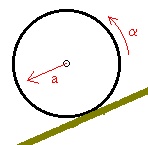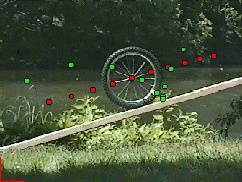Experiment E2262 Rotational Motion
Discussion
A bicycle wheel rolls down an inclined board. We say that it is translating and rotating. As the bicycle wheel rolls, the velocity of its center of mass will increase. If it rolls without slipping, then its angular velocity will also increase. Since the object is rotating and translating, it will have rotational kinetic energy as well as translational kinetic energy. What effect does the rotational kinetic energy have on the total energy in this situation? Will the total energy be conserved if we ignore the rotational kinetic energy?
The Model
Figure 2 shows a diagram of this experiment. As the bicycle wheel travels down the board, its center of mass will have an acceleration, a. If it rolls without slipping, then the wheel will also have an angular acceleration, a. This means that both the translational and angular velocities will be changing. Since translational and rotational kinetic energies depend on these velocities, then they will both be changing too.

Figure 2. As the bicycle wheel travels down the incline, the center of mass translates with an acceleration a, and the wheel rotates with an angular acceleration, a.
When an object is translating and rotating we can write the total mechanical energy as:
TE = KE + RE + PE
Here, KE is the translational kinetic energy of the center of mass, RE is the rotational kinetic energy relative to the center of mass and PE is the gravitational potential energy. These are written:
KE = 0.5mv2
RE = 0.5Icmw2
PE = mgh
The change in total energy is:
DTE = DKE + DRE + DPE
If the change in total energy is zero, then it is conserved and:
0 = DKE + DRE + DPE or -DPE = DKE + DRE
This means that a change in potential energy results in an opposite change in the sum of the translational and rotational kinetic energies.
Marking the Video
Click here to open the video.
- Play the video and observe the motion.
- Mark the wheel's center until the video does not step any more.
- Click the Data Set 1 button and its caption will change to Data Set 2. Mark the white spot on the tire until the video does not step anymore. These marks will be green circles.
- Use the Circles - Vectors menu item to observe first the velocity and acceleration and then the momentum and net force. What are your observations?
Graphical Analysis
- Press the GRAPHS Button and the Data Analysis Choices will appear. Pick Option 1. Click the Next button.
- Direction of Motion? Select x and y, and y is vertical.
- From the plots options select energy. Click the Next button.
- Observe the energy graph. This graph does not include the rotational kinetic energy. The total energy here is the sum of only the translational kinetic energy and the gravitational potential energy. Considering only these two energies, is the total energy conserved?
- Go to the data table and create a custom plot of KE versus PE. Does DKE = -DPE?
- Click the Data Analysis button, then the Back button until you see the Data Analysis Choices again.
- Choose Option 4, then click the next button.
- Select both x and y for the center of mass and the moving point. Also select y is vertical. Click the Next button.
- From the plots options select energy. Click the Next button.
- Observe the energy graph. The total energy now includes the rotational kinetic energy. Is the total energy now conserved?


